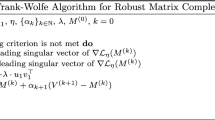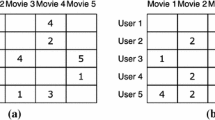Abstract
In matrix completion, additional covariates often provide valuable information for completing the unobserved entries of a high-dimensional low-rank matrix A. In this paper, the authors consider the matrix recovery problem when there are multiple structural breaks in the coefficient matrix β under the column-space-decomposition model A = Xβ + B. A cumulative sum (CUSUM) statistic is constructed based on the penalized estimation of β. Then the CUSUM is incorporated into the Wild Binary Segmentation (WBS) algorithm to consistently estimate the location of breaks. Consequently, a nearly-optimal recovery of A is fulfilled. Theoretical findings are further corroborated via numerical experiments and a real-data application.
Similar content being viewed by others
References
Salakhutdinov R and Srebro N, Collaborative filtering in a non-uniform world: Learning with the weighted trace norm, Advances in Neural Information Processing Systems, 2010, 23: 2056–2064.
So M C and Ye Y, Theory of semidefinite programming for sensor network localization, Mathematical Programming, 2007, 109(2–3): 367–384.
Argyriou A, Evgeniou T, and Pontil M, Multi-task feature learning, Advances in Neural Information Processing Systems, 2006, 19: 1–18.
Obozinski G, Taskar B, and Jordan M I, Joint covariate selection and joint subspace selection for multiple classification problems, Statistics and Computing, 2010, 20(2): 231–252.
Candès E J and Rech B, Exact matrix completion via convex optimization, Foundations of Computational Mathematics, 2009, 9(6): 717–772.
Candès E J and Terence T, The power of convex relaxation: Near-optimal matrix completion, IEEE Transactions on Information Theory, 2010, 56(5): 2053–2080.
Keshavan R H, Oh S, and Montanari A, Matrix completion from a few entries, IEEE Transactions on Information Theory, 2009, 56(6): 2980–2998.
David G, Recovering low-rank matrices from few coefficients in any basis, IEEE Transactions on Information Theory, 2011, 57(3): 1548–1566.
Recht B, A simpler approach to matrix completion, Journal of Machine Learning Research, 2011, 12(12): 3413–3430.
Candes E J and Yaniv P, Matrix completion with noise, Proceedings of the IEEE, 2010, 98(6): 925–936.
Recht B, Fazel M, and Parrilo P A, Guaranteed minimum-rank solutions of linear matrix equations via nuclear norm minimization, Society for Industrial and Applied Mathematics Review, 2010, 52(3): 471–501.
Koltchinskii V, Lounici K, and Tsybakov A B, Nuclear-norm penalization and optimal rates for noisy low-rank matrix completion, The Annals of Statistics, 2011, 39(5): 2302–2329.
Rohde A and Tsybakov A B, Estimation of high-dimensional low-rank matrices, The Annals of Statistics, 2011, 39(2): 887–930.
Srebro N, Rennie J D M, and Jaakkola T S, Maximum-margin matrix factorization, Citeseer, 2004, 17: 1329–1336.
Foygel R and Srebro N, Concentration-based guarantees for low-rank matrix reconstruction, JMLR Workshop and Conference Proceedings, 2011, 19: 315–340.
Tony Cai T and Zhou W X, Matrix completion via max-norm constrained optimization, Electronic Journal of Statistics, 2016, 10(1): 1493–1525.
Harper F M and Konstan J A, The movielens datasets: History and context, ACM Transactions on Interactive Intelligent Systems, 2015, 5(4): 1–19.
Chiang K, Hsieh C, and Dhillon I S, Matrix completion with noisy side information, Advances in Neural Information Processing Systems, 2015, 28: 3447–3455.
Zhu Y, Shen X, and Ye C, Personalized prediction and sparsity pursuit in latent factor models, Journal of the American Statistical Association, 2016, 111(513): 241–252.
Mao X, Chen S X, and Wong R K W, Matrix completion with covariate information, Journal of the American Statistical Association, 2019, 114(525): 198–210.
Zhang B, Geng J, and Lai L, Change-point estimation in high dimensional linear regression models via sparse group Lasso, Proceedings of the 2015 53rd Annual Allerton Conference on Communication, Control, and Computing (Allerton), Monticello, 2015, 815–821.
Piotr F, Wild binary segmentation for multiple change-point detection, The Annals of Statistics, 2014, 42(6): 2243–2281.
Killick R, Fearnhead P, and Eckley I A, Optimal detection of changepoints with a linear computational cost, Journal of the American Statistical Association, 2012, 107(500): 1590–1598.
Niu Y S, Hao N, and Zhang H, Multiple change-point detection: A selective overview, Statistical Science, 2016, 31(4): 611–623.
Sweeting T, Uniform asymptotic normality of the maximum likelihood estimator, The Annals of Statistics, 1980, 8: 1375–1381.
Little R J A and Rubin D B, Statistical Analysis with Missing Data, John Wiley & Sons, Hoboken, 2019.
Mazumder R, Hastie T, and Tibshirani R, Spectral regularization algorithms for learning large incomplete matrices, The Journal of Machine Learning Research, 2010, 11: 2287–2322.
Hao N, Niu Y S, and Zhang H, Multiple change-point detection via a screening and ranking algorithm, Statistica Sinica, 2013, 23(4): 1553–1572.
Wang D, Zhao Z, Lin K Z, et al., Statistically and computationally efficient change point localization in regression settings, Journal of Machine Learning Research, 2021, 22(248): 1–46.
Baranowski R, Chen Y, and Fryzlewicz P, Narrowest-over-threshold detection of multiple change points and change-point-like features, Journal of the Royal Statistical Society: Series B (Statistical Methodology), 2019, 81(3): 649–672.
Mao X, Wang Z, and Yang S, Matrix completion for survey data prediction with multivariate missingness, 2019, arXiv: 1907.08360.
Wang D, Yu Y, and Rinaldo A, Optimal change point detection and localization in sparse dynamic networks, The Annals of Statistics, 2021, 49(1): 203–232.
Venkatraman E S, Consistency Results in Multiple Change-Point Problems, Stanford University, Palo Alto, 1992.
Author information
Authors and Affiliations
Corresponding author
Ethics declarations
The authors declare no conflict of interest.
Additional information
This research was supported by the National Natural Science Foundation of China under Grant Nos. 12226007, 12271271, 11925106, 12231011, 11931001 and 11971247, the Fundamental Research Funds for the Central Universities under Grant No. ZB22000105 and the China National Key R&D Program under Grant Nos. 2022YFA1003703, 2022YFA1003800, and 2019YFC1908502.
Rights and permissions
About this article
Cite this article
Meng, J., Feng, L., Zou, C. et al. Covariate-Assisted Matrix Completion with Multiple Structural Breaks. J Syst Sci Complex 37, 692–728 (2024). https://doi.org/10.1007/s11424-023-2342-2
Received:
Revised:
Published:
Issue Date:
DOI: https://doi.org/10.1007/s11424-023-2342-2




